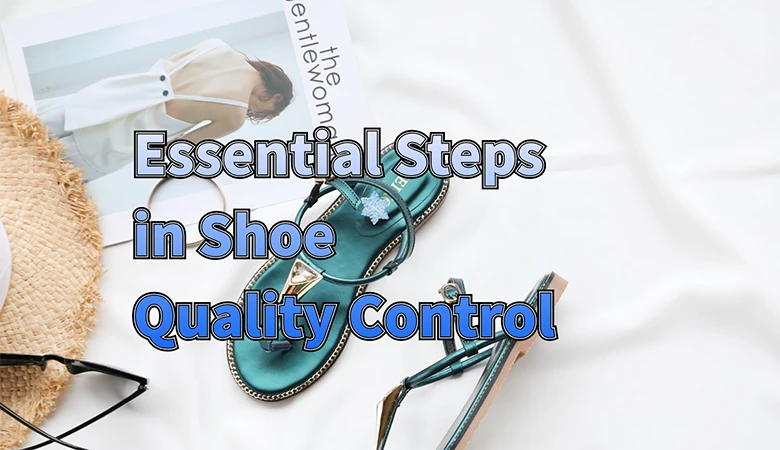
In the fiercely competitive footwear industry, ensuring that products meet high standards is crucial for gaining consumer trust and brand loyalty. Quality control (QC) helps manufacturers identify and eliminate defects, reduce waste, and ensure that shoes are durable, comfortable, and visually appealing. For consumers, quality assurance signifies reliable products that meet their expectations.
Effective quality control is a crucial tool for footwear manufacturers to maintain competitiveness, protect brand reputation, and ensure customer satisfaction. Poor-quality products may lead to high return rates, negative reviews, and ultimately loss of market share. By implementing robust QC measures, manufacturers can build consumer trust, reduce costs, and maintain product consistency and excellence.

Pre-production quality control
Material selection and inspection
In the footwear manufacturing industry, the starting point of the quality control process lies in the meticulous preparation before production. Among them, material selection and inspection are undoubtedly the key links that lay the foundation for high-quality footwear. Before the production curtain is opened, we must conduct a comprehensive and meticulous inspection of all kinds of raw materials used. These raw materials cover various types such as leather, textiles, rubber, and synthetic materials, each of which carries the important mission of shoe quality and comfort.
During the inspection process, every detail of the materials is strictly controlled, leaving no room for any potential defects. Whether it's irregular texture, inconsistent color, or potential issues with durability, all become the focus of scrutiny. Only those materials that have undergone rigorous screening to ensure superior quality are allowed to proceed to the production process, providing the guarantee for crafting a pair of high-quality shoes.
Sample approval process
The sample approval process serves as the first crucial step in transforming design concepts into actual finished products. Based on the original design specifications, samples are carefully crafted and subjected to a series of rigorous tests. These tests ensure that the design, craftsmanship, and performance of the shoes meet established standards, leaving no room for errors. Only when the samples excel in all tests and receive approval from relevant departments can the large-scale production plan be officially initiated. This process not only guarantees the accuracy of the shoe design but also lays a solid foundation for the subsequent production process.
Design and prototype evaluation
After the sample is approved, a more detailed inspection and evaluation of the prototype are conducted. During this process, the prototype is comprehensively analyzed from multiple dimensions, including fit, comfort, durability, and appearance. The close cooperation and feedback exchange between designers and manufacturers will provide valuable improvement suggestions. Guided by these suggestions, further improvements and optimizations are made to the shoes before full-scale production, ensuring that every pair of shoes is presented to consumers in its best condition.
Production line quality control
In the footwear manufacturing process, quality control on the production line is a crucial step to ensure that every pair of shoes meets high standards of quality. During this stage, a comprehensive monitoring system is established to conduct real-time and comprehensive tracking and monitoring of every aspect of the production line.
Monitor the production process
In the production process, any minor deviation can have a significant impact on the quality of the final product. It is essential to ensure that any deviation in the production process is immediately addressed through appropriate measures. The immediate response mechanism minimizes the risk of defects in the final product, thereby ensuring the quality of the shoes and consumer satisfaction.
Inspection and defect detection during the production process
Emphasis is placed on inspection and defect detection during the production process. Multiple checkpoints are set up at key stages such as sewing, assembly, and bonding to inspect each shoe individually. This helps to identify common issues such as uneven stitching, loose glue seams, or unsuitable components early on. Once these defects are discovered, they are immediately corrected to ensure that the problems are not carried over to the next production step, thereby guaranteeing the smoothness of the production line and the stability of shoe quality.
Ensure consistency across different production batches
Ensuring consistency across different production batches is also a crucial aspect of production line quality control. We understand that any inconsistency in quality between production batches can severely damage a brand's reputation and erode consumer trust. Therefore, we implement strict quality control (QC) measures on the production line to ensure that the size, fit, and material quality of shoes remain consistent across all production batches. These measures include regular calibration of production equipment, rigorous screening and testing of raw materials, and real-time monitoring and adjustment of key parameters during the production process. Through these measures, we ensure that every pair of shoes produced meets high quality standards, providing consumers with consistent and high-quality footwear products.
Final inspection and testing
Before the shoes are packaged and shipped, a comprehensive and meticulous inspection and testing procedure is strictly implemented.
Random sampling and inspection standards
Random sampling and inspection standards form the foundation of this process. A certain number of samples are randomly selected from the final production batch to ensure representativeness and fairness of the sampling. The samples undergo comprehensive inspection, covering multiple aspects such as size, weight, functionality, and overall quality. Detailed inspection standards are established to ensure that every pair of shoes meets these stringent requirements.
Functional testing (durability, comfort, fit)
Functional testing is crucial for evaluating the key performance of footwear. A good pair of shoes should not only have an attractive appearance but also possess excellent durability, comfort, and fit. Therefore, a series of functional tests were conducted on the samples. Durability tests, such as walking and running simulations that mimic real-world usage scenarios, can assess the wear resistance and stability of the shoes. Flexibility tests ensure that the shoes provide adequate support while maintaining flexible bending, meeting the needs of consumers in different sports activities.
Appearance and visual inspection (color, stitching, appearance)
Appearance and visual inspection cannot be overlooked. The appearance of shoes is the first thing that consumers notice, and it is essential to ensure that every pair of shoes presents a satisfactory visual effect. Inspectors need to carefully check the consistency of shoe colors, ensuring there are no color differences or fading. At the same time, they need to inspect the flatness and firmness of the stitching, as well as the fineness of surface treatment and the alignment of components. Only when all these aspects meet the brand's quality standards can the shoes successfully pass the final inspection and testing process, ready for packaging and shipping to consumers.
Packaging and label quality control
In the production process of footwear products, quality control of packaging and labeling is a crucial step to ensure that the products are presented perfectly to consumers.
Ensure proper packaging protection and display
Appropriate packaging can provide comprehensive protection for shoes during transportation, preventing them from being squeezed, bumped, or otherwise damaged, while also serving to attract consumers. Therefore, strict inspections are conducted on the structural integrity of the packaging. It is ensured that each pair of shoes is properly placed in a package with appropriate cushioning materials to prevent any displacement or damage during transportation. At the same time, the accuracy and completeness of labels are carefully checked to ensure that consumers can easily identify and choose their preferred products.
Label requirements and compliance
In terms of label requirements and compliance, strictly adhere to relevant local regulations and standards. Footwear labels must clearly indicate information such as material usage, origin, and safety certification, which is crucial for safeguarding consumer rights. Ensure that all label content is clear, accurate, and easy to read, so that consumers can fully understand all necessary information about the product when making a purchase and make informed choices.
Completeness and accuracy of packaging inspection
The completeness and accuracy of packaging inspection are also key points of our quality control. We have established a specialized packaging inspection process to ensure that each pair of shoes is packaged according to the prescribed standards. During the inspection process, we carefully check whether the left and right shoes are placed correctly, whether the size label matches the actual shoe, and whether the packaging components are complete and intact. Any minor errors may affect the shopping experience of consumers.
Post-production quality control
After the production process of footwear products is completed, the post-production quality control step ensures that the products can consistently meet high quality standards and provides valuable directions for future production improvements.
Final product evaluation and feedback
The evaluation and feedback of the final product is the primary task of post-production quality control. Once production is completed, a comprehensive evaluation of the final product is conducted. This evaluation process not only involves quality inspection of the product itself, but also includes tracking the performance of the product in actual use. Actively collecting feedback on product performance from retailers or distributors is like a valuable mirror, reflecting the true situation of the product in the market. We will carefully adopt these feedback opinions and make improvements in future production to ensure that the product can better meet the needs and expectations of consumers.
Handling of returns and defective products
Establishing an effective return and defective product handling system is crucial for safeguarding consumer rights and maintaining brand image. A smooth return process can reduce customer dissatisfaction and enhance their trust in the brand. The handling of defective products is also a crucial aspect that cannot be ignored. Careful analysis and recording of each pair of returned or defective products are necessary to identify the root cause of the problem. This valuable information will provide us with directions for improvement and help avoid similar issues in future production cycles.
Drive continuous improvement through quality indicators
Drive continuous improvement through quality indicators and data analysis. Establish a series of quality indicators, such as pass rate and defect rate, and conduct regular monitoring and analysis of these indicators. Through the defect tracking system, problems in the production process can be identified in a timely manner, and corresponding measures can be taken to correct them. At the same time, we attach great importance to consumer feedback, which serves as an important reference for improving product design and production processes. Through the comprehensive application of regular audits, defect tracking, and consumer feedback, continuous improvements are made in design, production, and materials, continuously enhancing product quality and competitiveness.
Common challenges in footwear quality control
In the footwear manufacturing industry, quality control is a crucial aspect to ensure product quality and meet consumer expectations. However, this process often comes with numerous challenges that manufacturers need to continuously address and overcome.
Changes in materials and production processes
Variations in materials and production processes pose one of the primary challenges for quality control in footwear. During the footwear production process, there may be differences in the sources and batches of raw materials, and the quality of materials provided by different suppliers may also vary. Simultaneously, minor changes in machine settings and production processes can impact the quality of the final product. These variations may lead to inconsistencies in the appearance, performance, or comfort of shoes, posing significant challenges to quality control. To address this challenge, manufacturers need to establish strict material inspection and production process control mechanisms to ensure that each batch of raw materials and production steps meet established quality standards.
Balance cost and quality standards
Balancing cost and quality standards is also a significant challenge in footwear quality control. Quality control typically involves additional inspection and testing expenses, which directly increase the cost of the product. However, in fierce market competition, manufacturers need to maintain competitive pricing while ensuring product quality. Sometimes, to reduce costs, manufacturers may face the risk of compromising on quality. To balance cost and quality standards, manufacturers need to continuously optimize production processes, improve production efficiency, and seek more cost-effective raw materials and testing methods to ensure that product quality is not sacrificed while controlling costs.
Respond to consumer expectations
Addressing consumer expectations is also a significant challenge in footwear quality control. As consumers' expectations for high-quality and more sustainable products continue to rise, manufacturers need to meet these demands without significantly increasing product costs. This requires manufacturers to possess keen market insight, accurately capture changes in consumer demand, and promptly adjust production strategies and product designs. At the same time, manufacturers also need to manage their production capabilities to ensure timely delivery of products that meet consumer expectations. To address this challenge, manufacturers need to continuously strengthen communication and exchange with consumers, establish close cooperative relationships, and jointly promote the quality improvement and sustainable development of footwear products.
END
The quality control of footwear involves a series of systematic steps, ranging from material inspection before production to evaluation after production. By implementing a robust quality control framework, manufacturers can ensure that products meet the highest standards of quality and consistency.
Effective quality control is not merely about reducing defects; it is also crucial for building trust and loyalty. Brands that consistently offer high-quality footwear products can establish a strong reputation and cultivate long-term consumer relationships.

Smart Sourcing & Quality Assurance Content Team
Article by Smart Sourcing & Quality Assurance Content Team
The Smart Sourcing & Quality Assurance Content Team is dedicated to delivering high-quality, easy-to-understand information that empowers our audience to navigate the complexities of global sourcing and quality assurance. Our team of writers has extensive experience in creating content across various fields, including procurement, supply chain management, quality assurance, market trends, and industry best practices. We specialize in sectors such as apparel, textiles, and consumer goods, providing targeted insights to help businesses in these industries optimize their sourcing strategies, ensure product quality, and maintain a competitive edge in the market.
Grow your business with TradeAider Service
Click the button below to directly enter the TradeAider Service System. The simple steps from booking and payment to receiving reports are easy to operate.

.png)

